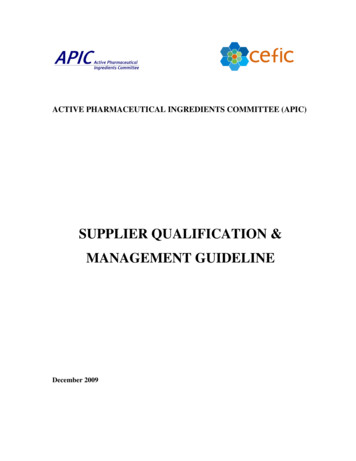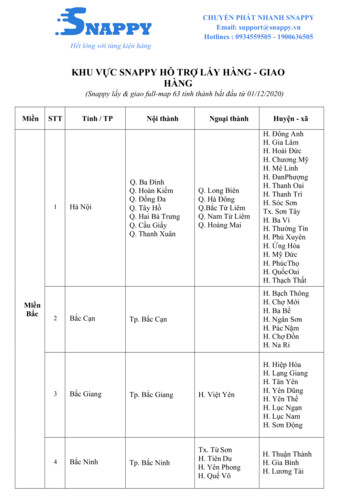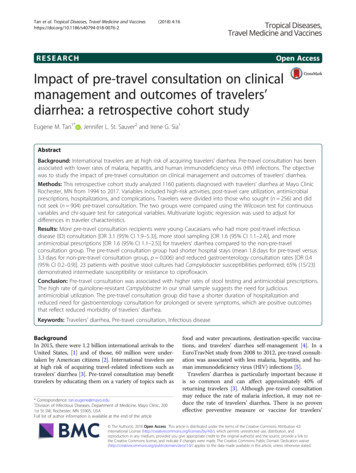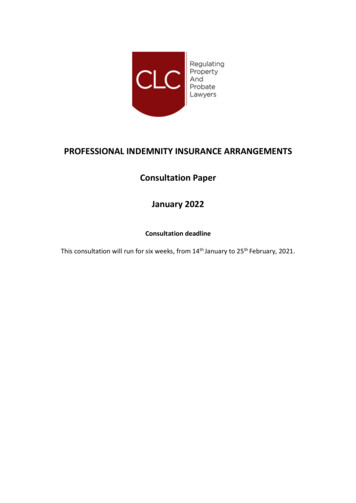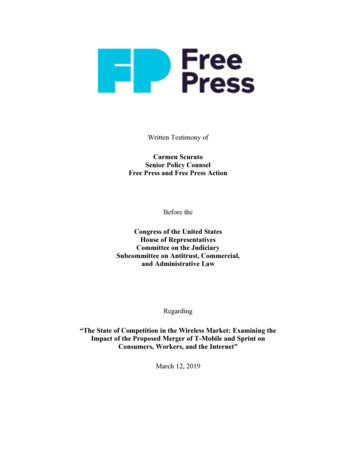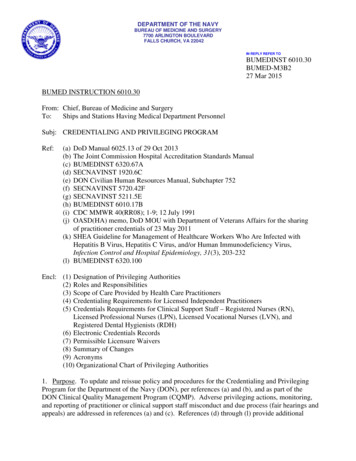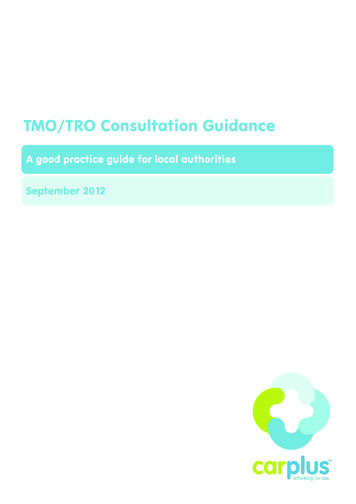
Transcription
TMO/TRO Consultation GuidanceA good practice guide for local authoritiesSeptember 2012
TMO/TRO Consultation Guidance forLocal AuthoritiesA good practice guide for local authoritiesSeptember 2012AcknowledgementsWe would like to thank Transport for London for their support and funding this publication aspart of the Carplus contribution to the delivery of Transport for London’s Car Club Strategy.Thanks to all those who contributed to this document including: London Boroughs of Hackney,Westminster, Islington and Merton, Surrey County Council, Project Centre, City Car Club,Greenwheels and ZipcarPlease send any comments or feedback to info@carplus.org.uk.TMO/TRO Consultation Guidance for Local Authorities, September 20121
ContentsSectionPageAcknowledgements . 1Abbreviations . 31.Introduction . 42.Process for bay allocation . 53.Consultation, information and promotion . 84.Objections . 13Appendix A - Sample consultation letter . 16Appendix B - Example objection letter . 17Appendix C - Member case studies . 19Appendix D - Template press release . 21TMO/TRO Consultation Guidance for Local Authorities, September 20122
AbbreviationsThe abbreviations used in this document are as follows:TMO/TROGLATfLCPZTraffic Management Order/Traffic Regulation Order outside LondonGreater London AuthorityTransport for LondonControlled Parking Zone1.Further Carplus Good Practice Guidance1.2.3.4.5.6.7.Electric Vehicles in Car ClubsCar Clubs Starter Pack for Local AuthoritiesCar Clubs at WorkCar Clubs in Property DevelopmentsCar Club ParkingMeet Policy Objectives with Low Carbon Car ClubsRunning an Informal Car ClubThese documents are available from www.carplus.org.uk/resourcesTMO/TRO Consultation Guidance for Local Authorities, September 20123
IntroductionThe purpose of this document is to provide good practice guidance for LocalAuthorities interested in promoting car clubs in their area through the provision ofon-street car club bays. The guidance sets out the process of placing an on-street carclub bay through a Traffic Management Order (TMO or TRO outside London).Carplus has produced this guidance to help local authorities with the process of publicising and consultingon car club bays. As well as making sure the right locations are chosen, there are many issues to considerabout how feedback is gathered and how to deal with objections most appropriately. Placing a car club bayon-street through a Traffic Management Order (TMO or TRO Traffic Regulation Order) can be a lengthy anddifficult process. Delays at this stage can cause problems for launching a car club as community momentumis lost, people decide to buy their own cars and operators struggle to plan their expansion.Removing parking spaces in an area with a high level of demand for parking is likely to cause controversy,even if this is based on a perception rather than the reality. Car clubs provide an alternative to owning acar. It has been proven that each bay can, on average, take twenty private cars off the road 1. In addition,bays can often be located in areas not normally used for residents parking. In order to minimise objectionsand the number of rejected bays, the process of introducing car club bays requires a thorough campaign ofeducation and promotion to residents. Introduction of a CPZ provides a unique opportunity to raiseawareness about alternatives to seeking a vehicle permit.Removing residents parking is never easy but two things need to be considered: The car club will help to ease congestion in the medium term. The evidence that people do sell carsas a result of becoming a car club member is well recognised so any objection based on existingparking stress should be discounted. Private car owners only make up a percentage of residents. Curb space belongs to all council taxpayers so ensuring that all residents are provided for rather than just car owners is vitallyimportant. Providing an avenue for residents to support a bay rather than just objecting to it istherefore very useful when establishing local support.Objections may not only come from residents. Councillors may also be unwilling to support proposals whichmay either be unpopular in the community or lose parking revenue, as in the case of using pay and displaybays.This guidance document provides a collection of good practice ideas from those working in the field toproactively address political and public concerns and convert them into support, and hopefully create carclub champions.For further information on implementing car clubs, please see the Carplus Car Club Starter Pack. Copies ofany of our guidance documents can be ordered from info@carplus.org.uk or can be downloaded free ofcharge at www.carplus.org.uk/resources.1Transport for London Car Clubs in London presentation at Forum 17TMO/TRO Consultation Guidance for Local Authorities, September 20124
2. Process for bay allocationThe process for allocating and implementing new car club bays starts with gainingpolitical support and involves identifying criteria for deciding on bay locations,consulting with the public on the chosen locations and then working towards atemporary/permanent order.Political supportFirstly, by gaining political support there will be a clearer agreement on the criteria for bays, support forobjections raised and a smoother implementation process. A policy statement demonstrating support forcar clubs will be invaluable when working across planning and parking teams and when to tackle reticenceor conflicting priorities.The inclusion of car clubs in the Local Implementation / Transport Plans (LIP/LTP) and Local DevelopmentFramework (LDF) Plans is invaluable. Ideally this should be backed by a general statement of support,introducing how car clubs contribute to a sustainable transport strategy approved at a full council meeting.Although several different officer teams are involved, it helps if there is clear leadership from thesustainable transport team so that the wider developmental issues are considered beyond purely practicalparking issues. One idea for gaining this support is for the transport officer to visit area committees,possibly with a representative from one of the operators, and encouraging at least one councillor to be achampion.Where possible, car clubs should also be included in wider strategic decisions, as happened with theControlled Parking Zone (CPZ) consultation in Islington. Islington Council included a question about carclubs in CPZ consultation documents and found that the responses were very useful in determining exactlywhere residents wanted car club cars to be located.Top down support is vital, first cabinet members should support the scheme so a statement to this effect isimportant. Then following this, the councillors should be engaged to ensure that they fully understandwhat is being done. No councillor wants to be caught on the back foot by a resident objecting to something– if they understand the benefits of what is being proposed, councillors can be really valuable allies incommunicating the benefits of car clubs to residents.Council strategyEach council will have a slightly different situation – from revenue pressures to parking stress toestablishing political buy-in – so local authorities should have a flexible approach to which bays should beconverted for car club use. The key to success is that the car club must be given a chance to succeed andthis will only happen if cars are placed in areas where they are most needed and will work best. Limiting carclubs to only converted pay and display bays or redundant yellow lines will make this success very difficultto achieve. As car club users are residents, it is advisable to consider conversion of some existing resident’sbays, as well as other off-street alternatives.Different authorities will have different priorities. Some favour converting pay and display bays as this isgenerally less controversial with the public and possibly faster to set up. Others chose to convert residentialbays so as not to lose revenue. The latter can often be easier to achieve during the addition of a CPZ as theaddition of a car club bay can be promoted as a positive contribution to the community, whilst otherTMO/TRO Consultation Guidance for Local Authorities, September 20125
restrictions are being added. However, residents may object as to why the council will not give up pay anddisplay revenue but will convert residential bays when the council policy is to support car clubs.There are alternative methods which should be considered, especially when support is low, these include: Converting areas of yellow single lines; Converting unused loading bays to car club bays; Identify spaces which are not currently allocated, such as where there is a change of use, or newstretches of road where former access roads between rows of houses have been in-filled with newhousing; and New developments can also provide bays for the surrounding community.Whichever policy for deciding the type of road space to use, it is necessary to remember that the locationsmust also be assessed for viability and accessibility by the residents and SMEs they serve.Expert advice on bay locationsBay locations should be identified by someone with expertise in highway and specifically parking design,issues as well as having knowledge of the local area. Without this there is a danger that a lot of locationswill prove unsuccessful.With the local authority’s priorities in mind it is a good idea to walk around the sites with the operators andtraffic engineers / consultants to take advantage of the wealth of knowledge each have. Their experiencewill be invaluable to help avoid pitfalls such as not choosing sites right outside someone’s house orreducing visibility for pedestrians crossing. There are several issues that will be important to car cluboperators in selecting bay locations: Tree cover - cars that are damaged by tree sap or birds will not be viable and will have to be movedat a later date, causing inconvenience to car club members.Lighting – Operators need their members to check for damage before their journey so the bay mustbe well lit.End of run bays – Car club members are occasional drivers who are often not as proficient atdriving as an average license holder. Asking them to parallel park between two cars is therefore nota great idea – provision of bays at the end of rows allows for easier parking and also helpsmaintenance teams to clean the vehicle.Locating bays close to other infrastructure – New bays should avoid impacting upon other roadinfrastructure such as cycle lanes, bus lanes or bus stops. Whilst it is the responsibility of the LocalAuthority to ensure that this does not happen, impacts upon cycle lanes in particular are bound tocause major objections/complaints once installed.Locating bays outside fast food outlets or leisure centres should also be avoided.By taking a collaborative approach a useful dialogue can take place about the different issues to consider,and a shortlist of sites can be identified with the maximum chance of being implemented and viable.Development strategyA further consideration when identifying potential bays is to keep in mind the aims of the car club. In orderto reduce traffic, increase use of public transport and reduce parking congestion, the spread of bays shouldseek to serve all residential and business areas where the basic criteria of a high density of population andgood public transport exist. This may include areas of social inclusion with fewer potential businessmembers. Clusters of bays in suitable locations may suit both car club operators and local residents.TMO/TRO Consultation Guidance for Local Authorities, September 20126
Key in the early stages is that car club bays are located where there is most demand rather than to meetpolitical aims (for example borough wide coverage). Only once success is assured (defined as profitable,long term viable operations) can boroughs work with operators on wider aims.The debate about whether to include more socially mixed areas will need to involve consideration of theobjectives for the car club with respect to social inclusion and whether it is possible to use more profitablebays as a means of support.TMO/TRO Consultation Guidance for Local Authorities, September 20127
3. Consultation, information & promotionImplementing the baysHaving chosen appropriate bays, the authority now needs to decide the best way to implement them.Broadly there are two choices each with their pros and cons.1) Experimental/Temporary TMO; or2) Full TMO.Experimental/temporary TMOWhen the concept is brand new to an area experimental/temporary traffic orders can be a good idea as itallows residents to see them in action. However, unlike permanent orders, which have the benefit of notrequiring further work after the trial period, temporary orders do. Furthermore, repeating the process willof course involve twice the costs. However temporary TMOs are fast to install and have been a useful toolto dissipate initial objections, encourage fewer bays to be overturned by the council due to objectionsrecieved and have gone on to be accepted by residents once they see how they work in practise. Theadvantages and disadvantages of full and temporary TMOs are summarised in Table 1.Using this strategy and consulting retrospectively could work either way in terms of getting support; itcould anger residents who have to live with the bay for 18 months without a say, or it could help to getthem on side and even encourage positive feedback by showing people how it works in practice.Full/permanent TMOFull traffic orders allow a much more detailed consultation process with residents and stakeholders tooccur. While this takes longer to do, no further action is needed once it is completed (unlike ExperimentalTraffic Orders). The case can be set out as to why the bays are proposed and how they will be of benefit tothe local area – this can help dissipate any potential objections and increases awareness generally of whatthe bays are. The disadvantage is that this approach can draw a significant number of objections dependingon the area which can take a long time to resolve sometimes delaying implementation. This can bemitigated to an extent by the way that consultation is done and more detail on this is included below.It should be noted however that the majority of authorities carry out only the level of consultation specifiedby the DfT, which is a standard sign at the location and an advert in at least one local newspaper. This iseasily missed by all but the most eagle-eyed residents and can cause problems further down the line.Ideally, a more thorough consultation should be undertaken to ensure that the needs and concerns of localresidents are met, particularly in new areas.TMO/TRO Consultation Guidance for Local Authorities, September 20128
Table 1 – Advantages and disadvantages of full and temporary TMOsTemporaryTMOPermanentTMOAdvantagesQuick to installEncourages fewer bays to be overturnedby the Council as a result of objectionsrecievedIdeal for use when faced with oppositionfrom residents in a location where a bayis required – temporary order givesthem an opportunity to see how bay willwork in practiceProvides opportunity for residents tocomment on bay before implementation(both for and against)Can be linked to general awarenessraising on car clubs (see below)DisadvantagesNo opportunity for residents to commentbefore/whilst bay is in placeLonger process to obtain a permanent TMOIf package of bays processed, risk thatopposition to few bays may delay overallprocessProviding information and promotion of car clubs before any bay specificconsultation process starts can help to ensure that local residents are aware of theconcept and the benefits of a bay being introduced in their neighbourhood.Paving the wayCreating a supportive climate for car clubs before a consultation exercise can make all the difference totheir success. As well as raising political awareness there are many ways to get the public on board. Gettingcar club features in the press, prior to a consultation process, could be a very powerful tool to pave theway, especially if the piece shows current members telling their positive experiences and highlights highlevels of customer satisfaction and personal benefits, such as cost savings and convenience. Stories can bebased upon new council support for new service, (eg: In Lambeth a councillor publicly gave up his car), thenth member for expansions or the financial and carbon savings from joining the car club.Similarly, articles in council publications can help to put across the benefits to the individual and thecommunity as well as dispelling the myths ahead of formal communications. Appendix C provides a list ofapproved case studies (Operators will be able to provide further locally tailored ones as necessary) whichTMO/TRO Consultation Guidance for Local Authorities, September 20129
can be used in press releases and Appendix D provides a template release which can be tailored to localsituation. Some authorities have even done a pre-door drop mailing giving people advance warning andopportunities to have the benefits of the car club explained.Other than using the press and door drops another useful way to raise awareness in the area is to addinformation boards to the existing bay stations like bus stop information points.Promotional approachWhen it comes to giving notice of the intention to change a parking space into a car club bay the bestresults tend to be produced by an upbeat promotional mailing rather than a dry official TMO letter. Thepromotional pack to residents usually includes:a covering letter – see Appendix A;a leaflet or newsletter covering what a car club is and their advantages;a plan of the location of the bays being proposed (see below); anda feedback card.In cases where the operator has already been chosen it makes sense to use their specific materials whichwill be recognisable and include details of their tariffs etc. Otherwise the generic car club branded materialscan be used and adapted, if necessary, with a panel giving local information and contact details. Some authorities feel that they should be impartial in their TMO communications. The risk of this approachis that it can raise unnecessary suspicions. It may be better to simply put up notices locally and in the paper,rather than highlight the car club plans in a mailing that is unable to explain the benefits.TMO/TRO Consultation Guidance for Local Authorities, September 201210
Encouraging positive feedbackCollecting positive feedback is a useful tool to help to convince councillors and counteract any complaints.By using a feedback card, which is quick and easy to complete, residents can register their support withouttoo much effort before they get distracted by other tasks (see example overleaf). Another good techniqueis to give local (potential) members the contact details to write or email to demonstrate demand for bays inthe area.It may also be worthwhile to expand the feedback questions to encourage constructive comments andavoid purely negative responses. For example, Do you support the concept of car clubs? Or gatheringfurther useful feedback by asking “Would you get rid of your car/defer the purchase of one if a car club caris implemented in your street? The latter could provide invaluable evidence for the overall benefits of thatparticular car club bay.TMO/TRO Consultation Guidance for Local Authorities, September 201211
TMO/TRO Consultation Guidance for Local Authorities, September 201212
4. ObjectionsWhen implementing bays, dealing with objections as part of the statutoryconsultation process is one of the key challenges facing officers. This chapter dealswith the main types of objections that might be received and how these can bedealt with.Well founded objectionsSometime objections are well founded as the locations that have been selected are found to have issuesaround safety or poor visibility. This highlights the need for a collaborative approach that feeds in expertisefrom all relevant departments and partners to identify problems during the process of bay identification.Pre-consultation objectionsOften it is useful to carry out some informal consultations with residents before the statutorycommunications go out. This provides an opportunity to contact people who have objected to the proposalto discuss any issues they may have and try to reach an agreement by which they feel encouraged towithdraw their objection before the scheme is formally consulted on. Objections to specific locations cansometimes have implications on the progress of an entire batch if they are to be incorporated into onereport. A summary of the bay consultation process is set out in Figure 1.Concerns over lost parkingThe majority of objections relate to the lack of parking supply for local residents. Fierce objections are oftenraised when the car club is seen to be taking away a further residents parking space. In the past this type ofobjection has been commonly upheld as this can be a political ‘hot potato’ but it has begun to change asthe profile of car clubs has risen. Having an official council policy of support for car clubs will help in thissituation as will an elected member champion to push for the objection to be overruled. See Appendix Bfor a sample reply. Many Local Authorities now discount entirely objections raised concerning parkingpressure on the basis of the positive effects that car clubs are proven to have.Other objectionsOther types of objections will include issues, such as: “I don’t want a business running in front of my door step”This can be avoided by choosing locations that are not directly in front of people’s entrances orthrough positive promotion. Alternatively a temporary TMO would allow residents to try it out andhopefully alleviate their concerns. Stressing who uses the car club car is also vital. Car club cars areused almost entirely by people within a 10 minute radius of the car so this is a local service for thebenefit of the local community. “The council is supporting a private company to make a profit. Car clubs are no better than hirecompanies”This can be counteracted by explaining the relationship with the operator and the council, thedifferences and benefits over car hire alongside direct dialogue during pre-consultation.TMO/TRO Consultation Guidance for Local Authorities, September 201213
“Car clubs are a bad idea because they encourage people to drive more”This comes down to providing further information about the environmental benefits andbehavioural changes created by car clubs.It is good practice for the Local Authority to inform Car Club operators about the objections received, sothat they can see if they have had any requests for cars in the area in question.Skipping some baysOften it is not worth pursuing every bay if there are strong objections. One problem bay can hold up a holdbatch so by dropping one bay you could make the rest of process smoother and faster.ConclusionsThe key to successful TMO / TRO bay implementation is to galvanise support frompoliticians, council colleagues and community champions through strongcommunications and education about the benefits of car clubs. Heading offobjections in advance is a more successful strategy than turning around negativefeeling, thus raising awareness of the benefits of car clubs in the area will create asupportive base for adding new bays. In addition, tapping into expertise from withinthe council on highways and the operators on car club issues will save time byavoiding poor locations.TMO/TRO Consultation Guidance for Local Authorities, September 201214
Figure 1 – Bay Consultation Process Summary FlowchartTMO/TRO Consultation Guidance, September 201215
Appendix A - Sample Consultation LetterCouncil/Consultant contact detailsDear Sir/Madam,Consultation on a proposed car club parking bay on street name[Consultant] is carrying out a consultation on behalf of Borough Council and we would like to know your views on theproposal to introduce a car club vehicle near where you live. We enclose a consultation pack and would be grateful ifyou could complete and return the comment card by end date.The car club has been operating successfully in Borough for X years and membership has more than quadrupled sinceXXXX year. The popularity of the scheme means there is further demand for car club vehicles and Borough Councilproposes to increase the number of car club parking bays available.A car club is, in essence, a car sharing network which provides an alternative to owning a car. A car club vehicle is parkednear where you live ready for hire. Unlike car rental companies, the vehicle is available for hire for just an hour as well ashaving daily and weekend rates. After joining the car club, a fee is charged whenever you use the vehicle. We enclose aleaflet providing further information on the benefits of the scheme.Research shows that people who drive less than a couple of times a week (or 6,000 miles per year) could save up to 1,500 annually by joining a car club. Even if you do not use car club yourself, it brings significant benefits to theenvironment. A car club scheme can remove twenty or more privately owned vehicles on the road as residents sell theirown cars or defer the purchase of a new one. This makes more parking spaces available to residents. Traffic and airpollution in residential streets is reduced as well as greenhouse gas emissions which cause global warming.For these reasons, Borough Council wants to increase the number of parking spaces for car club members throughoutthe borough and due to the popularity of the scheme it is proposed to introduce a car club vehicle on street name. Aplan of the proposal can be seen on the reverse of this letter.If you would like to comment on this car club proposal please complete the enclosed questionnaire and return it to usbefore end date. Alternatively, if you have any questions or would like to discuss the proposal please call theconsultation team on contact number. The comments you provide will be analysed and included in a report which will beprovided to Borough Council.I hope that you will be able to spend a few minutes to consider the proposal and look forward to hearing from you.Yours faithfully,[Lead officer/consultant][Position]TMO/TRO Consultation Guidance, September 201216
Appendix B – Example objection letterCouncil contact detailsName SurnameStreet NameLondonPostcode[Date]Dear ,Consultation on proposed car club parking bayThank you for replying to the consultation on the proposal to introduce a car club bay in [street, post code].We have noted your comments but would like to further clarify the proposal to help address the concernsyou’ve raised.In your email you mention that parking is already congested in your street and that the introduction of acar club bay will compound this. However, the car club bay would in fact have the opposite effect onparking congestion in your street. A study carried out by Carplus examined the impacts of car clubs onparking pressures in London. The results of the study showed that the introduction of a single car club carcan remove twenty or more existing privately owned vehicles from the road, as a result of deferredpurchase or selling of vehicles as a result of residents being given convenient access to car club vehicles.*This study therefore suggests that although one existing resident parking space would be lost as a result ofthis proposal, a net gain of three or more bays is likely to be achieved, which would actually reduce parkingpressures in your street rather than worsen them. In addition, without this proposal parking pressurescould worsen in your street, as in the absence of a viable alternative to car ownership, additional residentsmay choose to purchase otherwise unnecessary private vehicles.The national charity Carplus has also found that car clubs lead to a range of other environmental andtransport benefits. Because car club members have to book the car before using it, they make fewerimpulse trips than car owners. This means less traffic through your residential area and therefore saferstreets, less noise, cleaner air and fewer carbon emissions which cause global warming.**[Detailed response to other specific issues ] The pay and display parking you mention in your email hasbeen introduced to provide short term parking for visitors to the area and shoppers wishing to visit theshops on XXXX Road. It is therefore proposed to convert an existing resident parking space rather thanreduce the provision of short term parking which is a useful amenity to local people and businesses.TMO/TRO Consultation Guidance, September 201217
Because XX Borough residents are for the most part, like you, concerned about parking pressur
Greenwheels and Zipcar . TMO/TRO Consultation Guidance for Local Authorities, September 2012 2 Contents . . is lost, people decide to buy their own cars and operators struggle to plan their expansion. . clubs in CPZ consultation documents and found that the responses were very useful in determiningexactly


